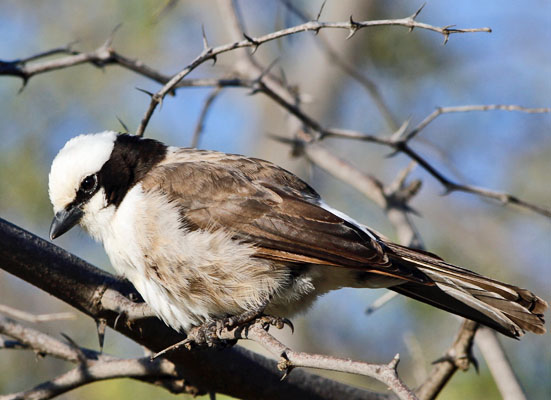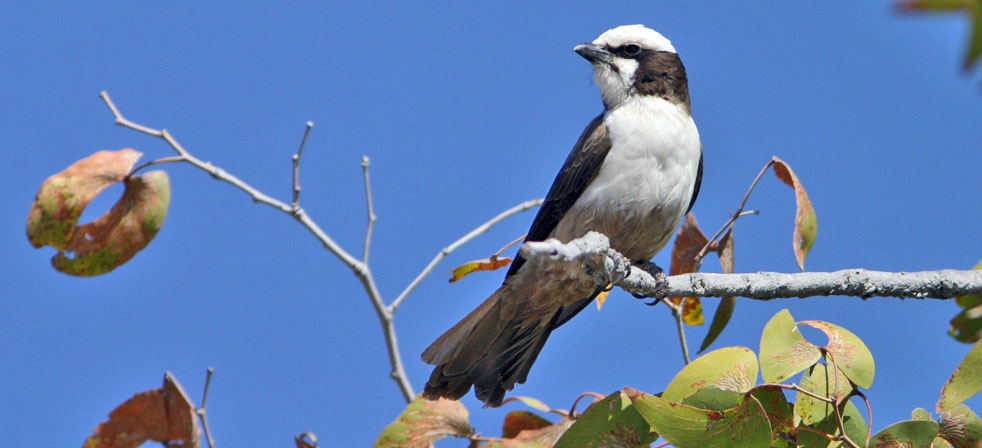| |
| |
WHITE-CROWNED SHRIKES Eurocephaliidae |
- 2 species in sub-Saharan Africa
- DR personal total: 2 species (100%), 2 photo'd
|
 The genus Eurocephalus holds two species of rather jay-like shrikes of thornscrub and open woodlands. A recent molecular study of all the shrike lineage (Fuchs et al. 2019) found evidence that these two species were more closely related to the Shrikejay Platylophus galericulatus, and opined that perhaps both should be in families separate from jays, on the one hand, and shrikes, on the other hand. It is not yet known if this will be widely adopted by global checklists, but I tentatively accept it here. The genus Eurocephalus holds two species of rather jay-like shrikes of thornscrub and open woodlands. A recent molecular study of all the shrike lineage (Fuchs et al. 2019) found evidence that these two species were more closely related to the Shrikejay Platylophus galericulatus, and opined that perhaps both should be in families separate from jays, on the one hand, and shrikes, on the other hand. It is not yet known if this will be widely adopted by global checklists, but I tentatively accept it here.
There used to be just one widespread species — the White-crowned Shrike — but then they were split into Northern White-crowned Shrike E. ruppelli and Southern White-crowned Shrike E. anguitimens, and then more recently were renamed White-rumped Shrike — the northern one, in east Africa (left) — and White-crowned Shrike — the southern one, in southern Africa (below). Both have white crowns but the southern species has a gray (not white) rump. |
 |
These are an engaging and energetic species, occurring primarily in pairs or small family groups, and they take their prey primarily from the ground. Zimmerman et al. (1996) pointed out that, unlike most African shrikes, they build a neat, compact, well-camouflaged nests, like helmet-shrikes and that they have scutellation extending down the sides as well as the front of the tarsus, unlike true shrikes.
As noted above, Fuchs et al. (2019) published a phylogeny of the shrikes, based on molecular evidence. Among their findings was that "Eurocephalus does not belong to the Laniidae family. Instead it is more closely related to a member of the Corvidae family: the Crested Jay (Platylophus galericulatus). The genus Eurocephalus should probably be placed in its own family." Perhaps because of the Covid pandemic, which interfered with all professions, this recommendation has not yet been adopted by global checklists. |
| |
Photos: The White-rumped Shrike Eurocephalus rueppelli was was in Tarangire NP, Tanzania, on 10 June 2018. The White-crowned Shrike Eurocephalus anguitimens was Etosha NP, Namibia, on 29 July 2005.
All photos © Don Roberson; all rights reserved.
Family Book: Rating: 
Harris, Tony. 2000. Shrikes & Bush-Shrikes. Illustrations by Kim Franklin. Princeton Univ. Press, Princeton, N.J.
This is a very attractive offering in the Princeton bird families series. Tony Harris wrote the text; Kim Franklin painted the plates. It has the familiar layout of plates altogether in the front, with range maps and i.d. summary, and detailed species accounts in the back. It covers all the shrikes in family Laniidae, but did not anticipate the split of Eurocephalus shrikes into a separate family. That could not have been reasonably anticipated in 2000.
It looks well researched and has a good bibliography. I very much enjoyed the full-page spreads, with black-and-white sketch, on each genus in the groups covered, that highlights the introduction. There is a lot of discussion of taxonomy but, unfortunately, the authors chose to follow the Sibley & Ahlquist (1990) approach of only two families: shrikes [Laniidae] and bush-shrikes [Malaconotidae]. All of the batises, wattle-eyes, helmet shrikes, and such things as flycatcher-shrikes, wood-shrikes, and philentomas, are thrown into the latter family. New research does not support this approach. As it turns out, the true shrikes are not the closest relatives to the rest of this set (e.g., Barker et al. 2004), so even the premise of this book proves false. Further, vangas (not included in this book) are closely related to the rest of the group. Indeed, it appears that the flycatcher-shrikes are vangas, and that helmet-shrikes are very closely related to vangas. The text also suffers from the author's use of the "Species Recognition Concept" as his definition for species; fortunately, in practice, in works rather like the tried-and-true "Biological Species Concept." Yet both in its language and in its reliance on DNA hybridization evidence (Sibley & Ahlquist 1990), this book has the unfortunate status of being out-of-date taxonomically much more quickly than would be anticipated.
That having been said, the species accounts, maps, and paintings for the species that are included all are very good. This is a well-written book with attractive paintings. It is great to have a world overview of the species that are included, even if they do not hang together as a group. One major annoyance: citations in the text are small-print superscript numbers. A list of these numbers is in the back of the book, but the list does not give the full citation. Rather, citation number 732 is "Emlen 1979." One then has to go check the bibliography to locate the full citation to Emlen's note in Scopus on fiscal shrikes. This is an entirely unnecessary double effort for the reader, and should have been fixed by the publisher (just number the bibliography if you use this tactic; see Dickinson 2003 for an example of the proper way to do this). Despite all these criticisms, it IS a very attractive publication and quite useful in many ways. So I give it 4 (of 5) stars despite its limitations. The basic, underlying information about each taxa, and the attractive plates, make up for a lot.
In addition, I should mention that there is an earlier book focused just on this family: Norbert Lefranc & Tim Worfolk's (1997) A Guide to Shrikes of the World. Alas, I never read that book in any detail but my first impression in a book store was positive. In addition, the Laniidae section in the Birds of Africa series (Fry & Keith 2000) has a excellent introduction to the African species, as is Yosef (2008) for a worldwide overview.
Literature cited:
Fry, C.H., and S. Keith, eds. 2000. The Birds of Africa. Vol. 6. Academic Press, London.
Fuchs, J., P. Alström, R. Yosef, and U. Olsson. 2019. Miocene diversification of an open-habitat predatorial passerine radiation, the shrikes (Aves: Passeriformes: Laniidae). Zoologica Scripta, 48: 571–588.
Fuchs, J., R.C.K. Bowie, J. Fjeldsa, and E. Pasquet. 2004. Phylogenetic relationships of the African bush-shrikes and helmet-shrikes (Passeriformes: Malaconotidae). Molec. Phylog. Evol. 33: 428–439.
Yosef, R. 2008. Family Laniidae (Shrikes), pp. 732–782 in Handbook of the Birds of the World (del Hoyo, J., A. Elliott & D. Christie, eds). Vol. 13. Lynx Edicions, Barcelona, Spain.
Zimmerman, D.A., D.A. Turner, and D.J. Pearson. 1996. Birds of Kenya and northern Tanzania. Christopher Helm, London.
|
|
|


 The genus Eurocephalus holds two species of rather jay-like shrikes of thornscrub and open woodlands. A recent molecular study of all the shrike lineage (Fuchs et al. 2019) found evidence that these two species were more closely related to the Shrikejay Platylophus galericulatus, and opined that perhaps both should be in families separate from jays, on the one hand, and shrikes, on the other hand. It is not yet known if this will be widely adopted by global checklists, but I tentatively accept it here.
The genus Eurocephalus holds two species of rather jay-like shrikes of thornscrub and open woodlands. A recent molecular study of all the shrike lineage (Fuchs et al. 2019) found evidence that these two species were more closely related to the Shrikejay Platylophus galericulatus, and opined that perhaps both should be in families separate from jays, on the one hand, and shrikes, on the other hand. It is not yet known if this will be widely adopted by global checklists, but I tentatively accept it here.